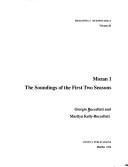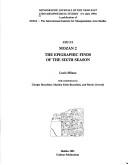| Listing 1 - 10 of 10 |
Sort by
|
Book
Year: 2001 Publisher: Malibu (Calif.) : Undena,
Abstract | Keywords | Export | Availability | Bookmark
 Loading...
Loading...Choose an application
- Reference Manager
- EndNote
- RefWorks (Direct export to RefWorks)
Book
ISBN: 8021087544 9788021087545 9788021087538 8021087536 Year: 2017 Publisher: Brno
Abstract | Keywords | Export | Availability | Bookmark
 Loading...
Loading...Choose an application
- Reference Manager
- EndNote
- RefWorks (Direct export to RefWorks)
Hurrians --- Religion. --- Urkesh (Extinct city) --- Antiquities. --- Religious life and customs.
Book
ISBN: 9780979893711 Year: 2011 Publisher: Malibu : Undena Publications,
Abstract | Keywords | Export | Availability | Bookmark
 Loading...
Loading...Choose an application
- Reference Manager
- EndNote
- RefWorks (Direct export to RefWorks)
Terracotta figurines, Ancient --- Urkesh (Extinct city) --- Mozan, Tall (Syria) --- Tall Mozan (Syria) --- Tell Mozan (Syria) --- Urkeš (Extinct city) --- Syria --- Antiquities

ISBN: 0890031940 0890031959 Year: 1988 Publisher: Malibu Undena
Abstract | Keywords | Export | Availability | Bookmark
 Loading...
Loading...Choose an application
- Reference Manager
- EndNote
- RefWorks (Direct export to RefWorks)
Excavations (Archaeology) --- Urkesh (Extinct city) --- Mozan, Tall (Syria) --- Tall Mozan (Syria) --- Tell Mozan (Syria) --- Urkeš (Extinct city) --- Syria --- Antiquities
Book
ISBN: 9780979893704 Year: 2007 Publisher: Malibu Undena
Abstract | Keywords | Export | Availability | Bookmark
 Loading...
Loading...Choose an application
- Reference Manager
- EndNote
- RefWorks (Direct export to RefWorks)
Terracotta figurines, Ancient --- Urkesh (Extinct city) --- Mozan, Tall (Syria) --- Tall Mozan (Syria) --- Tell Mozan (Syria) --- Urkeš (Extinct city) --- Syria --- Antiquities
Book
ISBN: 9780979893728 0979893720 Year: 2016 Publisher: Malibu (Calif.) : Undena Publications,
Abstract | Keywords | Export | Availability | Bookmark
 Loading...
Loading...Choose an application
- Reference Manager
- EndNote
- RefWorks (Direct export to RefWorks)
Urkesh (Extinct city) --- Mozan, Tall (Syria) --- Tall Mozan (Syria) --- Tell Mozan (Syria) --- Urkeš (Extinct city) --- Antiquities. --- Syria --- Antiquities
Book
ISBN: 9783447107976 Year: 2017 Publisher: Wiesbaden : Harrassowitz Verlag,
Abstract | Keywords | Export | Availability | Bookmark
 Loading...
Loading...Choose an application
- Reference Manager
- EndNote
- RefWorks (Direct export to RefWorks)
Book
ISBN: 9783447058919 Year: 2014 Publisher: Wiesbaden : Harrassowitz ,
Abstract | Keywords | Export | Availability | Bookmark
 Loading...
Loading...Choose an application
- Reference Manager
- EndNote
- RefWorks (Direct export to RefWorks)
Band 1 der Serie A, "Die Architektur und Stratigraphie", stellt den ersten Teil des Endberichtes der Ausgrabungen in der Zentralen Oberstadt von Tall Mozan/ Urkes in Nordost-Syrien dar. Die Forschungen der Universität Tübingen stellten eine ununterbrochene Siedlungsabfolge von der ersten Hälfte des 3. bis in die zweite Hälfte des 2. Jahrtausends v. Chr. fest. Die zentrale Terrasse aus Lehmziegel, auf der ein Tempelgebäude stand und die in ihrer Größe vergleichbar ist mit den Stufenpyramiden (Zikkuraten) des südlichen Mesopotamiens, sowie der freie zentrale Platz waren über den gesamten Zeitraum hinweg in kaum veränderter Weise in Benutzung. Zusammen mit der in der Unterstadt durch geomagnetische Prospektion und Oberflächenbegehungen beobachteten regelmäßigen hexagonalen Gesamtanlage verraten sie eine zentral gelenkte räumliche Organisation der damals als Urkes bekannten Stadtsiedlung. Das in der Oberstadt ergrabene Wohnviertel war in der Frühen Bronzezeit durch eine kleinteilige Bebauung gekennzeichnet, die einen sozial niedrigen Stand der Bewohnerschaft verrät. Am Ende des 3. Jahrtausends wurde neben den einfachen Wohnhäusern ein großes Gebäude errichtet, das als Wirtschaftsgebäude gedeutet werden kann. Zu Beginn des 2. Jahrtausends schließlich entstanden geräumigere und besser gebaute Wohnhäuser, die sich in der Ausrichtung und in der Größe gleichen und über ein regelmäßiges Wegenetz erschlossen sind. Diese Jahrhunderte andauernde Kontinuität des öffentlich genutzten Raumes bietet zusammen mit den Veränderungen des privaten Raumes ein lebendiges Bild der damals bedeutenden Stadt Urkes.
Excavations (Archaeology) --- Urban ecology (Biology) --- Fouilles archéologiques --- Écologie urbaine --- Urkesh (Extinct city) --- Fouilles archéologiques --- Écologie urbaine

ISBN: 0890032769 Year: 1991 Volume: 5/1 Publisher: Malibu Undena
Abstract | Keywords | Export | Availability | Bookmark
 Loading...
Loading...Choose an application
- Reference Manager
- EndNote
- RefWorks (Direct export to RefWorks)
Cuneiform inscriptions, Akkadian --- Excavations (Archaeology) --- Inscriptions cunéiformes akkadiennes --- Fouilles (Archéologie) --- Syria --- Mozan, Tall (Syria) --- Syrie --- Mozan, Tall (Syrie) --- Antiquities --- Antiquités --- Inscriptions cunéiformes akkadiennes --- Fouilles (Archéologie) --- Urkesh (Extinct city) --- Antiquities. --- Antiquités --- Akkadian language --- Texts --- Tall Mozan (Syria) --- Tell Mozan (Syria) --- Urkeš (Extinct city)
Book

ISBN: 128354816X 9786613860613 1400833043 0691154430 0691133336 9780691133331 9781400833047 9780691154435 9780691154435 Year: 2012 Publisher: Princeton, NJ
Abstract | Keywords | Export | Availability | Bookmark
 Loading...
Loading...Choose an application
- Reference Manager
- EndNote
- RefWorks (Direct export to RefWorks)
The international controversy over who "owns" antiquities has pitted museums against archaeologists and source countries where ancient artifacts are found. In his book Who Owns Antiquity?, James Cuno argued that antiquities are the cultural property of humankind, not of the countries that lay exclusive claim to them. Now in Whose Culture?, Cuno assembles preeminent museum directors, curators, and scholars to explain for themselves what's at stake in this struggle--and why the museums' critics couldn't be more wrong. Source countries and archaeologists favor tough cultural property laws restricting the export of antiquities, have fought for the return of artifacts from museums worldwide, and claim the acquisition of undocumented antiquities encourages looting of archaeological sites. In Whose Culture?, leading figures from universities and museums in the United States and Britain argue that modern nation-states have at best a dubious connection with the ancient cultures they claim to represent, and that archaeology has been misused by nationalistic identity politics. They explain why exhibition is essential to responsible acquisitions, why our shared art heritage trumps nationalist agendas, why restrictive cultural property laws put antiquities at risk from unstable governments--and more. Defending the principles of art as the legacy of all humankind and museums as instruments of inquiry and tolerance, Whose Culture? brings reasoned argument to an issue that for too long has been distorted by politics and emotionalism. In addition to the editor, the contributors are Kwame Anthony Appiah, Sir John Boardman, Michael F. Brown, Derek Gillman, Neil MacGregor, John Henry Merryman, Philippe de Montebello, David I. Owen, and James C. Y. Watt.
Antiquities -- Collection and preservation -- Moral and ethical aspects. --- Antiquities -- Collection and preservation -- Social aspects. --- Cultural property -- Protection. --- Cultural property -- Repatriation. --- Excavations (Archaeology) -- Moral and ethical aspects. --- Museum exhibits -- Moral and ethical aspects. --- Museums -- Acquisitions -- Moral and ethical aspects. --- Museums -- Philosophy. --- Museums --- Museum exhibits --- Cultural property --- Antiquities --- Excavations (Archaeology) --- General --- Museum Publications --- Moral and ethical aspects --- Acquisitions --- Protection --- Repatriation --- Collection and preservation --- Social aspects --- Philosophy --- Moral and ethical aspects. --- Social aspects. --- Protection. --- Repatriation. --- Philosophy. --- Display techniques --- Displays, Museum --- Museum displays --- Archaeological digs --- Archaeological excavations --- Digs (Archaeology) --- Excavation sites (Archaeology) --- Ruins --- Sites, Excavation (Archaeology) --- Repatriation of cultural property --- Cultural property, Protection of --- Cultural resources management --- Archaeological specimens --- Artefacts (Antiquities) --- Artifacts (Antiquities) --- Specimens, Archaeological --- Exhibitions --- Government policy --- Law and legislation --- Restitution --- Public institutions --- Cabinets of curiosities --- Museum techniques --- Archaeology --- Cultural policy --- Historic preservation --- Material culture --- 037 --- 069.01 --- 7.025.7 --- 7.025.7 Kunstwerken: verlies, teloorgang door o.a. diefstal of tijdens transport --- Kunstwerken: verlies, teloorgang door o.a. diefstal of tijdens transport --- 069.01 Museologie --- Museologie --- Collection and preservation&delete& --- Acquisitions&delete& --- musea --- Musées --- Objets exposés --- Biens culturels --- Antiquités --- Fouilles (Archéologie) --- Aspect moral --- Collections et conservation --- Aspect social --- Philosophie --- Accessibility. --- American Journal of Archaeology. --- American Schools of Oriental Research. --- Ancient Egypt. --- Ancient Greece. --- Ancient Greek art. --- Antiquities. --- Archaeological context. --- Archaeological site. --- Archaeology. --- Art Loss Register. --- Art museum. --- Arts and Crafts movement. --- Beijing. --- Benin. --- Burial. --- Cambridge University Press. --- Capital Museum. --- Censorship. --- Circumstantial evidence. --- Civilization. --- Collecting. --- Colonialism. --- Consideration. --- Cosmopolitanism. --- Country of origin. --- Crime. --- Criticism. --- Cultural Property (Japan). --- Cultural appropriation. --- Cultural heritage. --- Cultural nationalism. --- Cultural property law. --- Cultural property. --- Curator. --- Elgin Marbles. --- Epigraphy. --- Euphronios Krater. --- Fu Hao. --- Funding. --- Iconoclasm. --- Ideology. --- Indigenous peoples. --- Insider. --- Institution. --- Intellectual property. --- International Council of Museums. --- J. Paul Getty Museum. --- Jews. --- Kenya. --- Kwame Anthony Appiah. --- Lansdowne portrait. --- Lecture. --- Legislation. --- Literature. --- Looting. --- Material culture. --- Matthew Bogdanos. --- Member state. --- Metropolitan Museum of Art. --- Museum. --- National Museum of the American Indian. --- National Palace Museum. --- National Treasure (Japan). --- National treasure. --- Native American Graves Protection and Repatriation Act. --- Neolithic. --- Newspaper. --- Ownership. --- Partage. --- Personhood. --- Philistinism. --- Private collection. --- Provenance. --- Publication. --- Punitive expedition. --- Repatriation (humans). --- Rhetoric. --- Roman art. --- Ruler. --- Smithsonian Institution. --- Smuggling. --- Sophistication. --- State ownership. --- Statute. --- Superiority (short story). --- Taliban. --- Tax. --- The Hundreds. --- The New York Review of Books. --- The New York Times. --- Theft. --- Tomb of Fu Hao. --- Tomb. --- Treaty. --- Tribal art. --- UNESCO. --- Urkesh. --- Work of art. --- World Heritage Site.
| Listing 1 - 10 of 10 |
Sort by
|

 Search
Search Feedback
Feedback About UniCat
About UniCat  Help
Help News
News